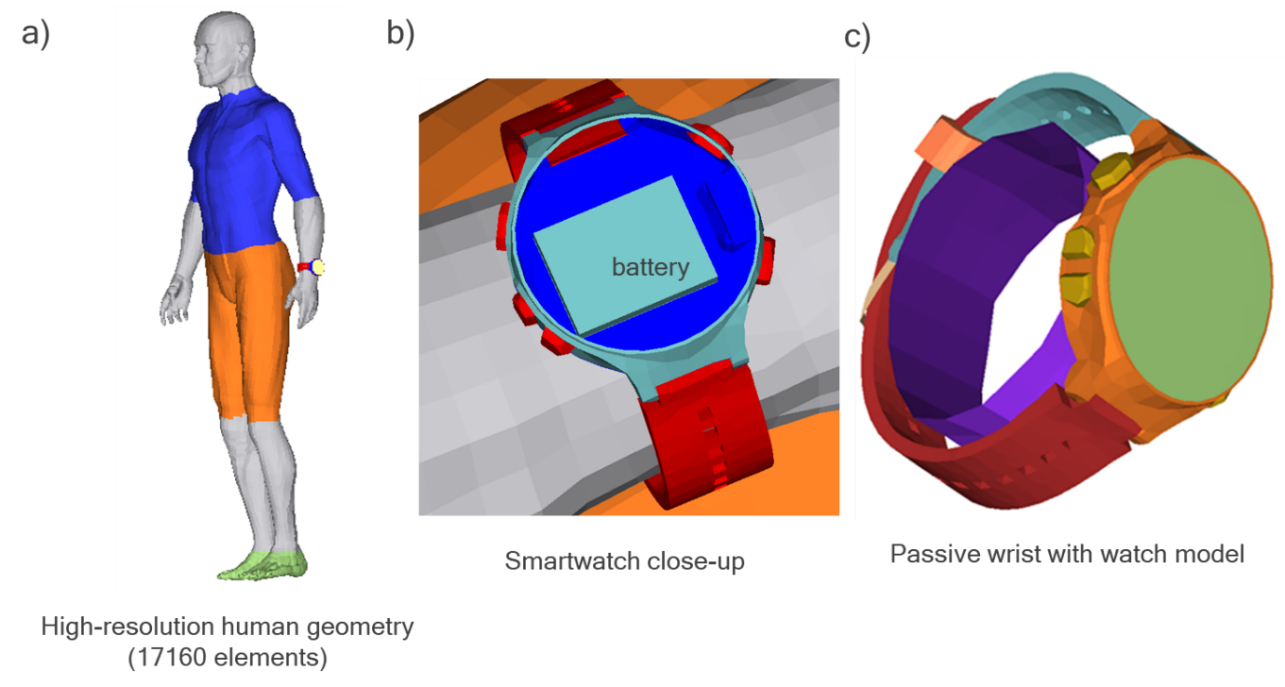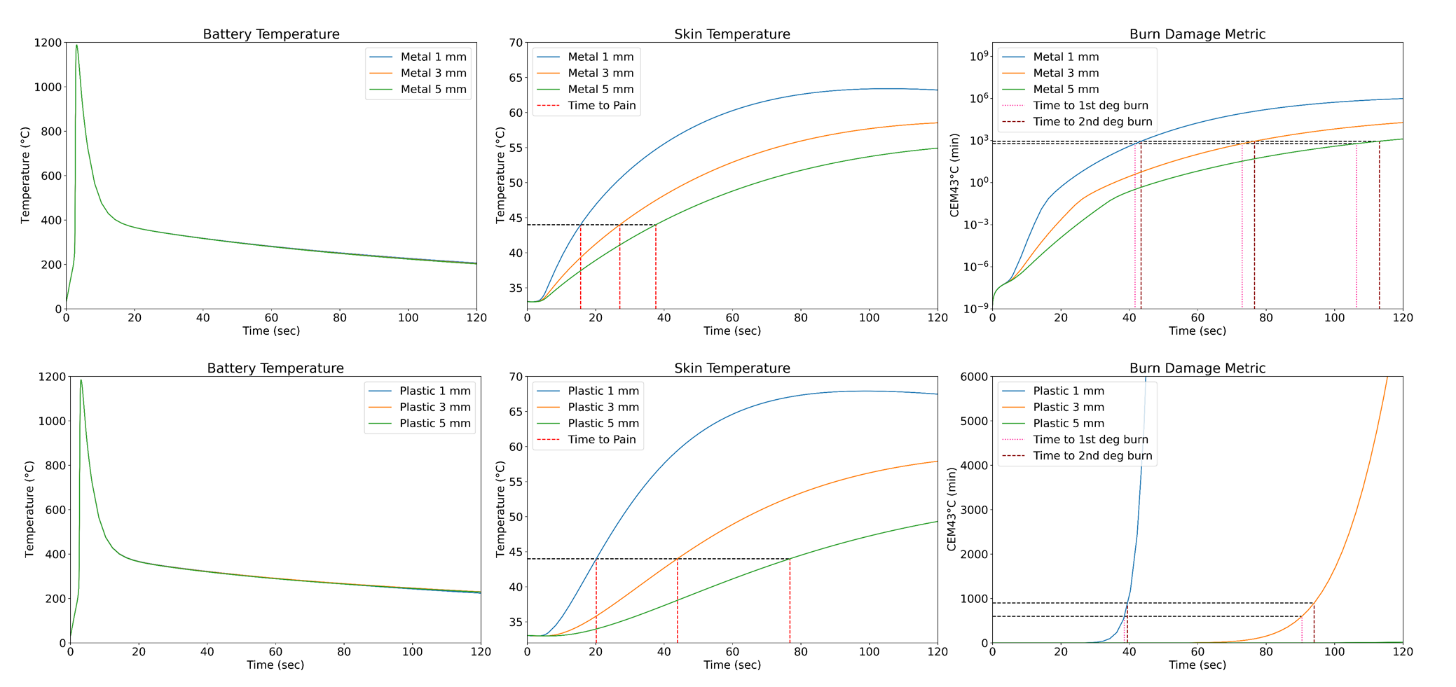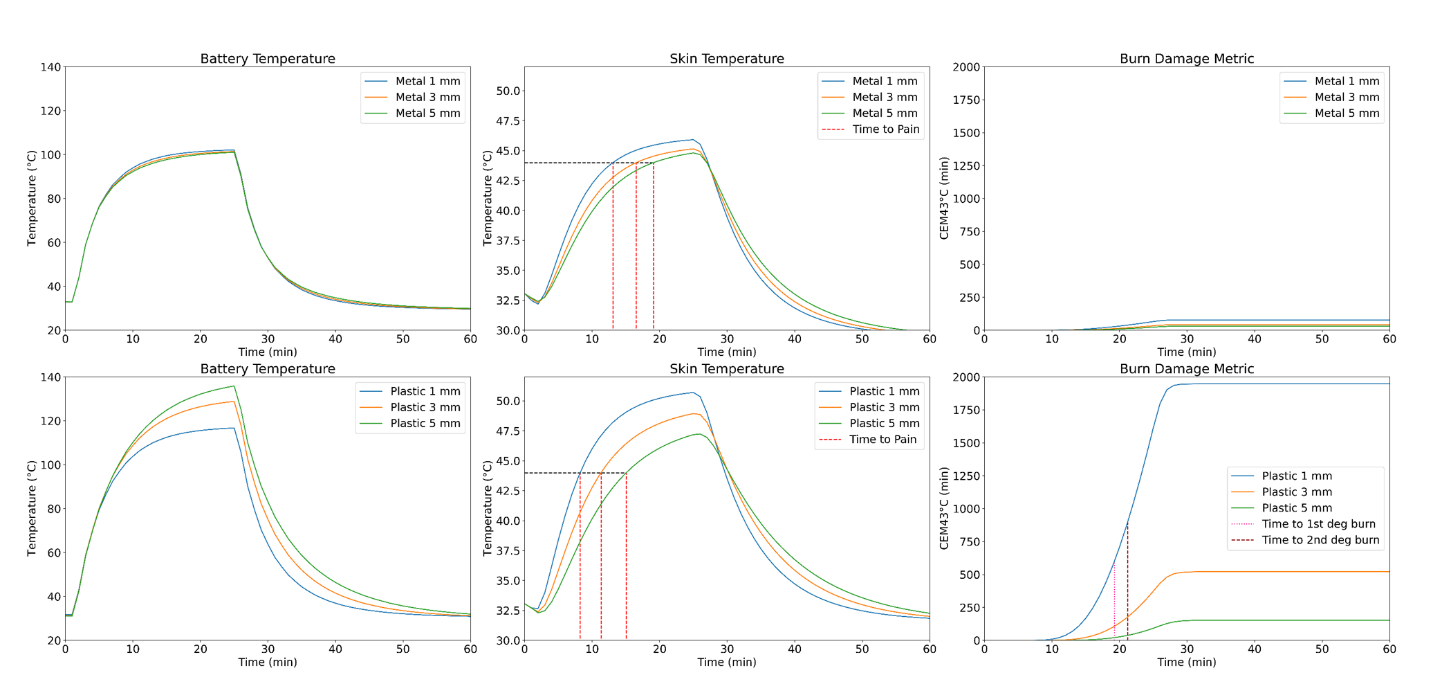INTRODUCTION
Wearable electronic devices such as smartwatches and fitness trackers present a risk of thermal injury from battery overheating due to their proximity to the skin [1, 2]. In some scenarios, particularly those involving vigorous exercise, users may not realize when the device's elevated temperature poses a risk of tissue damage. Understanding the specific heat transfer and burn hazards in various scenarios can help improve smartwatch design and enhance user safety during a battery failure. For example, safety mechanisms can be incorporated into devices to alert users before battery failure, allowing them time to react and remove the device.
Thermal simulation software can accurately estimate the time to burn in different scenarios and assess how wearable electronics design influences burn risk under various conditions. This study aims to develop an approach for predicting burns caused by an overheating battery in a smartwatch. A sensitivity analysis evaluates the impact of watch construction material and thickness, ambient temperature, and exercise intensity.
METHODS
The TAITherm Human Thermal Model (HTM) was used to model the human body and the smartwatch. It utilizes a three-dimensional heat transfer model based on the bio-heat transfer equation to predict tissue temperatures, including skin and core temperatures. The model incorporates active physiological responses such as sweating, shivering, and vasomotion to mimic the central nervous system's thermal stimuli response. This allows for predicting the battery's temperature evolution, skin temperatures, and burn risk. The simulation models are shown in Figure 1.

Two battery thermal failure scenarios are considered: thermal runaway due to a short circuit (worst-case scenario) and gradual overheating (more common scenario). The thermal runaway scenario uses the NREL Thermal Runaway Model [3] to describe heat generation from unwanted chemical reactions at high temperatures. The gradual overheating scenario applies a constant heat rate to the battery.
Tissue damage to the skin depends on tissue temperature and thermal exposure duration. The cumulative equivalent minutes at 43 °C (CEM43) model is used to quantify tissue damage based on thermal dose over time [4]. The CEM43 model’s predictions can be used to identify the extent of thermal injury, categorized as follows: 1st-degree burn occurs at CEM43 = 600 minutes, and 2nd-degree burn at CEM43 = 900 minutes [5].
RESULTS
The effect of smartwatch construction material and thickness on skin temperature, time to pain, and burn risk is presented in Figure 2 and Figure 3. In both thermal runaway and gradual heating scenarios, increasing smartwatch material thickness decreases the risk of burn. This suggests that less thermally diffusive materials like thick plastics increase the time to burn, reducing the risk of thermal injury.


Two exercise intensities were also examined to evaluate their impact on skin temperature and burn risk. Exercise intensity in the HTM is specified in terms of metabolic equivalence of task (MET), where 1 MET is the rate of energy produced per unit surface area of an average person seated at rest and is defined as 58.2 W/m2 [6]. Results showed that maximum skin temperature and CEM43 are lower for higher exercise intensity (9 MET) than for resting metabolism (1.2 MET) (Figure 4). This is a consequence of thermoregulatory mechanisms acting within the human body. The higher exercise rate scenario initially has a higher skin temperature under the smartwatch. As the scenario progressed, the onset of thermoregulation mechanisms (more increased skin blood flow and sweat evaporation) reduced skin temperature under the smartwatch.

CONCLUSIONS
This study presents a computer simulation framework for predicting thermal injury caused by an overheating battery in wearable devices. Two battery overheating scenarios, thermal runaway and gradual heating, were evaluated. In thermal runaway, 3-5 mm thick metal watches have a shorter time to pain and higher burn risk compared to plastic watches of the same thickness due to lower heat conduction in plastic. However, metal watches exhibit lower burn risk in gradual heating scenarios due to better heat dissipation. Increasing watch construction thickness reduces burn damage, regardless of the battery overheating scenario. The human thermal model also enables consideration of human-specific heat transfer variability in burn risk assessments. For example, exercise intensity significantly lowered burn risk in longer exposure durations due to increased sweating and blood flow.
If you want to learn more about using TAITherm to determine advanced thermal comfort simulation metrics, please request a live demo of our software.

Visit our website at suppport.thermoanalytics.com for
- FAQs
- Webinars
- Tutorials
Get help from our technical support team:
REFERENCES
- Thorbecke, “Fitbit recalls 1.7 million smartwatches due to burn hazard,” CNN Business, March 2, 2022, Retrieved November 2, 2022, from https://www.cnn.com/2022/03/02/tech/fitbit-ionic-recall/index.html
- Hector, “Samsung Galaxy Watch user claims wearable burned their wrist,” TechRadar, September 20, 2022, Retrieved November 2, 2022, from https://www.techradar.com/news/samsung-galaxy-watch-user-claims-wearable-gave-them-third-degree-burns
- Kim, A. Pesaran, R. Spotnitz, A three-dimensional thermal abuse model for lithium-ion cells, Journal of Power Sources 170 (2007) 476-489
- Sapareto SA, Dewey WC., "Thermal dose determination in cancer therapy," Int J Radiat Oncol Biol Phys. 1984;10:787–800
- Yen, F. Colella, H. Hytomaa, B. Allin, A. Ockfen, “Contact Burn Injuries: Part 1: The influence of object thermal mass,” 2020 IEEE Symposium on Product Compliance Engineering - (SPCE Portland).
- 2005 ASHRAE Handbook: Fundamentals, American Society of Heating, Refrigeration and Air-Conditioning Engineers, Atlanta, 2005, pp. 8.1-8.29.

